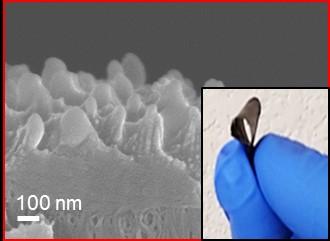In addition to protection from exposure to hazardous agents in the environment, a completely effective protective garment must also minimize physiological burden and prevent the risk of heat stress. The garment should allow facile perspiration and efficient heat loss from the body by evaporative cooling. Unfortunately, the techniques for protection and breathability (i.e., rapid water vapor transport) often work at cross purposes in a single material. Current protective materials sacrifice breathability in order to prevent exposure to harmful agents. They are typically either impermeable barriers that entirely block penetration of chemical and biological hazards (but also of water vapor), or heavy-weight laminates containing adsorbents for harmful agents.
Macroporous membranes with high permeability to moisture vapor and air offer poor protection from hazardous materials. Because the ability of these materials to protect typically relies on hydrophobicity/oleophobicity, low-tension liquids can penetrate their porous network structure and potentially shuttle in other hazardous components. Furthermore, these macroporous materials are ineffective against vapor phase threats.
Recent approaches to achieve adequate breathability in protective materials typically encompass selective monolithic membranes made of novel hydrophilic polymers, or multifunctional materials containing chemical groups/oxide nanoparticles with antibacterial or self-decontamination ability.
LLNL researchers have developed an alternative route to protective breathable membranes called Second Skin technology, which has transformative potential for protective garments. These membranes are expected to be particularly effective in mitigating physiological burden.
- Bui, N., Meshot, E.R., Kim, S., Peña, J., Gibson, P.W., Wu, K.J. and Fornasiero, F. (2016), Carbon Nanotubes: Ultrabreathable and Protective Membranes with Sub-5 nm Carbon Nanotube Pores (Adv. Mater. 28/2016). Adv. Mater., 28: 6020-6020. https://doi.org/10.1002/adma.201670197
- Li, Y., Chen, C., Meshot, E. R., Buchsbaum, S. F., Herbert, M., Zhu, R., Kulikov, O., McDonald, B., Bui, N. T. N., Jue, M. L., Park, S. J., Valdez, C. A., Hok, S., He, Q., Doona, C. J., Wu, K. J., Swager, T. M., Fornasiero, F., Autonomously Responsive Membranes for Chemical Warfare Protection. Adv. Funct. Mater. 2020, 30, 2000258. https://doi.org/10.1002/adfm.202000258
- Fornasiero, F., Water vapor transport in carbon nanotube membranes and application in breathable and protective fabrics. Curr. Opin. Chem. Eng. 2017, 16, 1-8. https://doi.org/10.1016/j.coche.2017.02.001
- Jue, M. L., Buchsbaum, S. F., Chen, C., Park, S. J., Meshot, E. R., Wu, K. J. J., Fornasiero, F., Ultra-Permeable Single-Walled Carbon Nanotube Membranes with Exceptional Performance at Scale. Adv. Sci. 2020, 7, 2001670. https://doi.org/10.1002/advs.202001670
- Membranes provide effective protection from biological threats by size exclusion rather than by merely preventing wetting.
- Material combines high breathability and protection in a single functional material
- CNT pore membranes provide faster than bulk permeability which is expected to enable filtration profiles not possible with current dialysis membranes.
Uses of innovative LLNL CNT membranes include:
- Breathable membranes and fabrics
- Protective membranes
- Membrane distillation
- Pervaporation
- Water purification and desalination
- Dialysis membranes
LLNL researchers have fabricated and tested cm2-area, flexible membranes. They have demonstrated that these membranes provide rates of water vapor transport that surpass those of commercial breathable fabrics, even though the pores are only a few nm wide and the overall porosity is less than 5.5%.
Current stage of technology development: TRL 2-4 depending on application area
LLNL has patent(s) on this invention:
- U.S. Patent No. 8940173 Membranes with functionalized carbon nanotube pores for selective transport published 01/27/2015
- U.S. Patent No. 11590459 Nanoporous membranes for fast diffusion of ions and small molecules published 02/28/2023
- U.S. Patent No. 10737128 Ultra-breathable and protective membranes with sub-5 nm carbon nanotube pores published 08/11/2020
- U.S. Patent Application No. 2020/0407525 Porous Polymer Membranes Comprising Vertically Aligned Carbon Nanotubes, and Methods of Making and Using Same published 12/31/2020
- U.S. Patent Application No. 2020/0238284 FLUIDIC CARBON NANOTUBE DEVICE published 07/30/2020
- U.S. Patent Application No. 2022/0062885 REACTIVE MEMBRANE NETWORKS FOR CWA PROTECTION published 03/03/2022
LLNL is seeking industry partners with a demonstrated ability to bring such inventions to the market. Moving critical technology beyond the Laboratory to the commercial world helps our licensees gain a competitive edge in the marketplace. All licensing activities are conducted under policies relating to the strict nondisclosure of company proprietary information.



